Rosewood is also known as rosewood, which is actually the translation from rosewood, English name. Name rosewood comes from the fact that, freshly cut, it has a sweet and very persistent smell, similar to rose blossoms. Sometimes the smell of the wood can last for years. Unlike species such as oak, acacia, cherry, nuc, ulm, which can be found in Europe, rosewood is an exotic wood specific to the tropics, with most commercial species from Central and South America, Africa and South Asia. Incidentally, under the name palisander around 300 species of the genus Dalbergia, spread all over the world. They share a sweet smell and a special colour, but not all species have the same colour. They all have a reddish tinge that combines with brown, orange, maple or black. The wood is hard and very precious, with a characteristic natural sheen. The colour, lustre and hardness have caused the wood to be exploited uncontrolled over time, which has led to protective measures for all species of the genus, with felling being restricted.
About rosewood species, wood characteristics and uses, below.
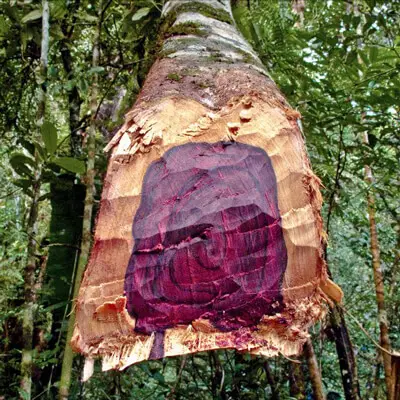
photo source: blackmagic.com.au
Hard and tough wood in exquisite natural colours
Rosewood species are the rarest, most distinctive and most prized wood species in the world. Each object made from such wood is unique, exuding strength and elegance at the same time. Dense and with full, rich hues, rosewood has been used for centuries to make luxury furniture, valuable musical instruments, clocks and jewellery boxes.
Rosewood heartwood comes in a wide variety of shades, from golden orange to greenish-black. Darker bands are interspersed in the basic heartwood colour giving the appearance of ribbons. Darker or darker colours can also appear on the same piece of wood in the form of straight or interconnected stripes forming stunning patterns.
Rosewood is hard, dense and strong. It is a very slow-growing wood, sometimes taking over 300 years to have a large enough piece of heartwood. Average anhydrous density is between 800 and 900 kg/m³, but some species can be even heavier than water (the wood sinks, not floats on water). The vast majority of species are resistant to decay and insect attack, even termites. It's like a kind of immunity that makes it not need insect-fungicide treatment.
Dalbergia, the genus to which the rosewood belongs, has over 300 species. The differences between them are related to colour, number and arrangement of pores. Species such as Kingwood, Blackwood, Tulipwood, Cocobolo, Sissoo or Bois de Rose also belong to the genus Dalbergia. But the best known species of rosewood are Dalbergia nigra, Brazilian rosewood and Dalbergia latifoliaIndian rosewood.
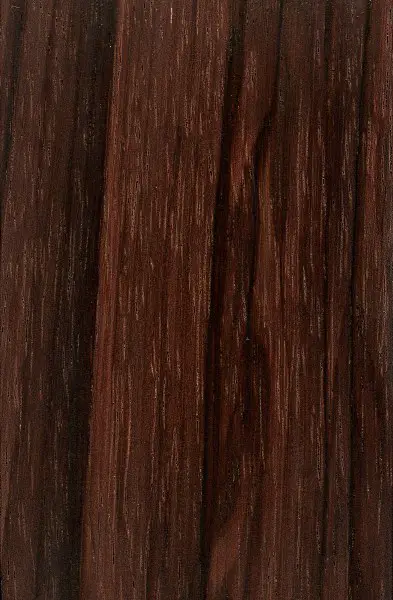
photo source: wood-database.com
Brazilian rosewood, a species almost impossible to find
Brazilian rosewood has been used for hundreds of years to make guitars with a special look and resonance. It is so highly prized that it is called by connoisseurs Cadillac of wood species. Much of the appreciation is also due to the fact that it is very hard to find. Intense logging during colonial rule, as well as clear-cutting and burning to make way for diamond mines or coffee farms, has led to the near extinction of the rosewood forests. It is thought that the area of Atlantic coastal forest, similar in density to the Amazon rainforest, but largely made up of rosewood trees, is 90% extinct. Since 1998, the Brazilian rosewood is a protected species.
The tree is native to Brazil and can reach 40 m in height, with trunk diameters of up to 1.5 m. In cross-section the difference between sapwood and heartwood is clearly visible. The sapwood is light yellowish, while the heartwood can vary from dark chocolate brown to light purple or reddish brown with dark contrasting stripes. Fine black stripes can sometimes form a unique pattern called cobwebn. The texture is uniform, medium to coarse, with medium-sized open pores. Fibre tends to be straight, but can sometimes be spiral or wavy.
Brazilian rosewood has a density of 835 kg/m³ and a hardness of Janka 12400 N. It is highly resistant to rot and insect attack. It works well manually and mechanically, but the tools must be sharp and it melts quickly. During processing it gives off a pleasant rose scent. Turns and sands easily, but there can be problems when gluing due to the oil content.
Brazilian rosewood is listed in CITES Apendix I, the most restrictive and includes finished wood products. It is the only species whose restriction has been tightened, all other species in the genus Dalbergia are in Apendix II. Because it is almost impossible to find it is often replaced by cocobolo, Honduran rosewood or Indian rosewood.

photo source: wood-database.com
Indian rosewood, a substitute for Brazilian rosewood in guitar making
Dalbergia latifolia, Indian rosewood has been traded for hundreds of years. Logging is now strictly controlled by the Indian government, and logs are sold at auction only to government-approved buyers. Export is strictly controlled by the government so that this precious wood remains available long into the future. Export controls date back to the early 1980s, and the exported wood must be of high value-added, such as veneer or components for musical instruments and furniture.
The tree is native to India, Sri Lanka and Indonesia. It can grow up to 30 m tall and 1.2 m trunk diameter. It is also called Bombay rosewood. The heartwood, different from the light-coloured sapwood, can range from a golden brown to deep purple brown with darker brown streaks. The wood darkens in colour with age, becoming deep brown. Texture is medium and pores quite small. Grains are usually tightly interwoven.
The pores are diffuse, medium to large, with no specific arrangement. The Indian rosewood has a much larger number of pores than the Brazilian rosewood, which is a recognisable feature. Narrow rays, invisible to the naked eye.
Anhydrous density is 830 kg/m³ and Janka hardness 10870 N. It is resistant to rotting and insect attack. It is difficult to process because of the interwoven fibres and it melts quickly. When processed it gives off a rose scent, but less pleasant than Brazilian rosewood. It glues well, but when staining there can be problems due to the resins it contains coming to the surface. Insulator should be used. It has been used since the 1960s as a replacement for Brazilian rosewood for making classical guitars.

photo source: 1stdibs.com
Uses of rosewood
Rosewood is a precious wood, very expensive and hard to find. It has been used extensively in the past to make luxury furniture, clocks, travel trunks and jewellery boxes, and to clad walls and case the ceilings of temples and palaces.
Today, furniture made of rosewood is very expensive and very rare. Most often species that look similar but are not part of the Dalbergia genus are used. Genuine species are mostly used for luxury items such as pens, pipes, chess sets.
Rosewood is a resonant wood whose sound when struck is clear and clean. That's why it has been used for hundreds of years to make guitars, as well as wind instruments such as the bassoon and clarinet.
Due to its dark colour it is frequently used for inlays.
The special colour of rosewood has led to the emergence of dyes in a similar shade. Sometimes the fact that it is mentioned palisander furniture may lead us to believe that it's actually of the species mentioned. It is, however, furniture of a common species, stained in rosewood colour. An identifying feature of the original furniture is the wide variation of colours on the surface of the same piece of wood. Rosewood-coloured furniture is uniform, and even if the wood used has a special pattern, the wood cannot reproduce the natural shades of rosewood.
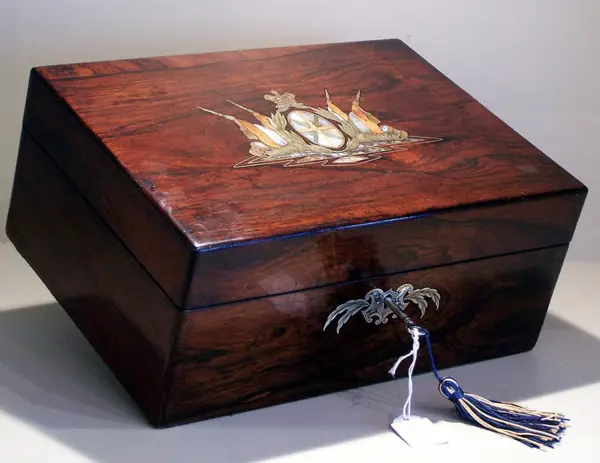
photo source: onlinegalleries.com
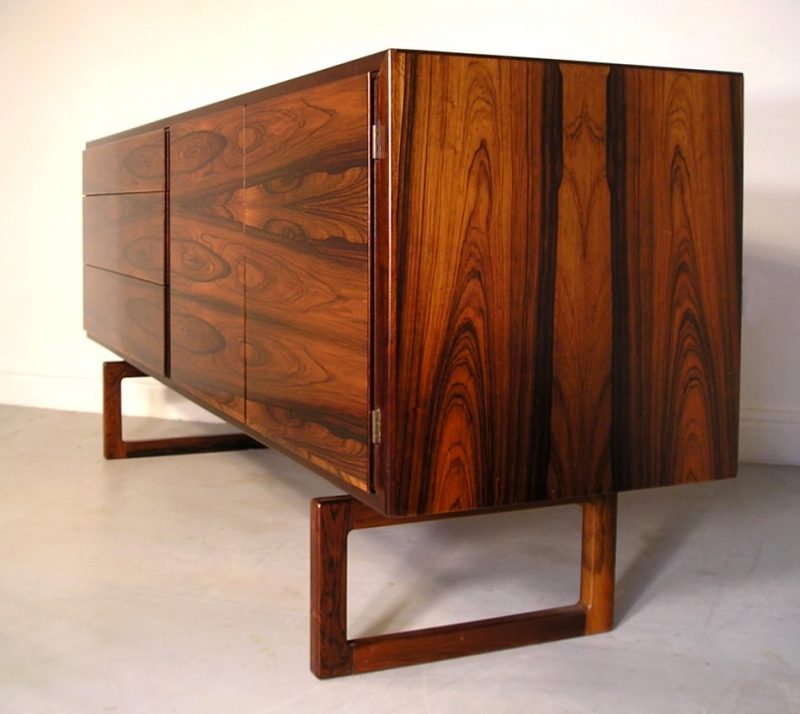
photo source: midcenturyhome.co.uk
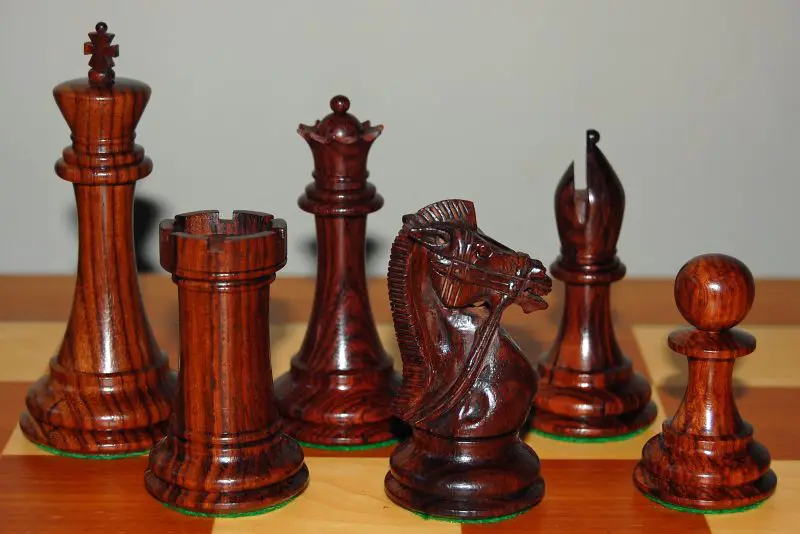
photo source: commons.wikipedia.org
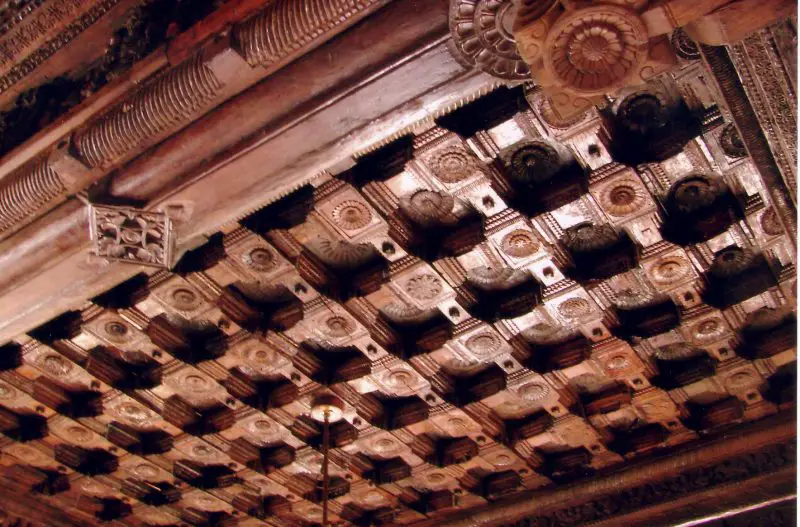
photo source: interiordesignassist.wordpress.com
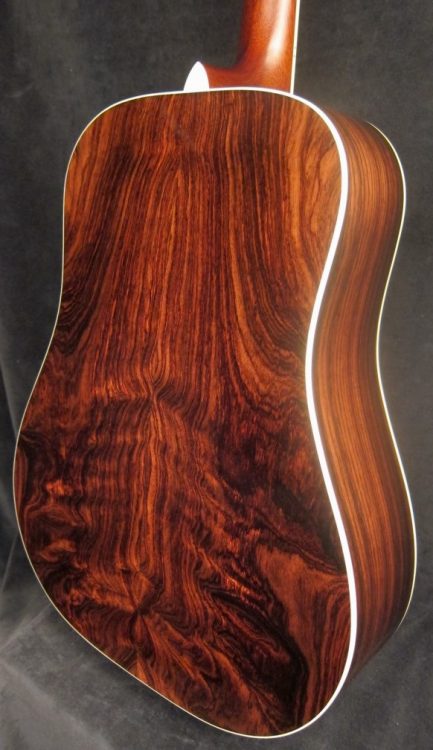
photo source: santacruzguitarcompany.com
Species increasingly hard to find
Massive logging for centuries has brought the rosewood close to extinction in many parts of the world. This has led CITES (the Convention on International Trade in Endangered Species of Wild Fauna and Flora) to place all species of rosewood under protection and restrict their exploitation.
I hope you find the above information useful. As usual, additions are welcome. And if you have any questions or queries, please leave them in the space below. I'm sure I'll reply.




























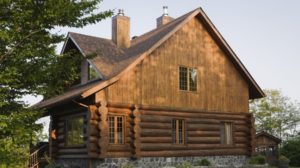

Could you share some information about the hairwood and the mimosas (silk tree)?
I came into possession of a hair trunk, which was cut just when it turned 100 years old, because the new owner didn't like it.Unfortunately I only managed to "save" a 90 cm long part.I have never seen a hair trunk so thick - after cutting it at the gater I ended up with 19 pieces with the size of 90X50X4-5 cm (lengthXwidthXthickness).
I also recently came into possession of a mimosas trunk 1.6 meters long and 30 cm in diameter (again I think such thicknesses are hard to see in this species), which has a superb fiber in my opinion.
My job has nothing to do with wood, but I try to continually accumulate information, and what I do is just a hobby.
Thank you!
I promise that very soon (probably next week) there will be an article about hairwood. For the silk tree I'll have to do more research, but it will come soon.
All the best.